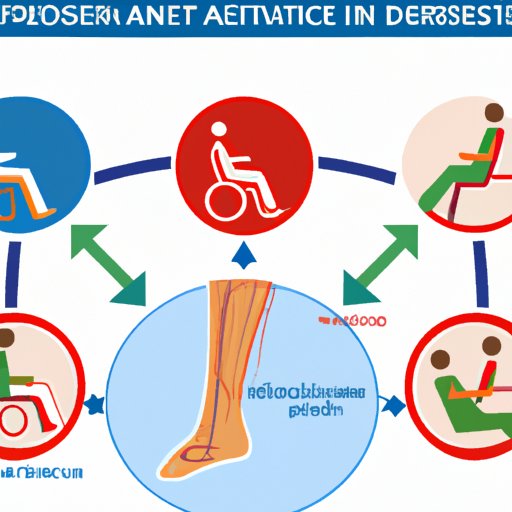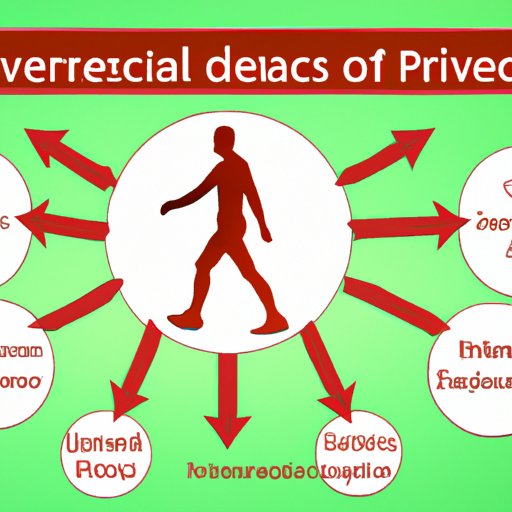
Introduction
Peripheral Arterial Disease, also known as PAD, is a condition where the arteries in the legs become narrow or blocked due to a buildup of plaque. This can lead to reduced blood flow, which can cause pain, numbness, and even tissue death. PAD affects approximately 8 million Americans, and the incidence of PAD increases with age. This article will explore the definition, symptoms, causes, and risk factors of PAD, as well as diagnosis and treatment options, lifestyle changes, and support resources.
Understanding Peripheral Arterial Disease: Symptoms, Causes, and Risk Factors
Peripheral Arterial Disease is characterized by the narrowing of arteries in the legs, which can cause leg pain or cramping when walking or exercising. Other symptoms include numbness, weakness, and a sensation of coldness or tingling in the legs. The condition can progress and lead to wounds that are difficult to heal or even gangrene, which can lead to amputation. Risk factors that contribute to the development of PAD include smoking, high blood pressure, high cholesterol, obesity, and a family history of heart disease or stroke.
Your Guide to Peripheral Arterial Disease: Diagnosis and Treatment Options
If you think you might have Peripheral Arterial Disease, it is important to see a healthcare professional for proper diagnosis and treatment. There are several diagnostic methods, including the ankle-brachial index, which compares the blood pressure in your ankle to that in your arm, and a duplex ultrasound that uses sound waves to create images of your blood vessels. Depending on the severity of your condition, your healthcare provider may recommend medications such as blood thinners or cholesterol-lowering drugs. In advanced cases, surgical interventions such as angioplasty or bypass surgery may be necessary. You should also focus on managing your symptoms and reducing your overall risk factors to prevent further complications.
Peripheral Arterial Disease: A Silent but Deadly Condition
Peripheral Arterial Disease is often referred to as a “silent but deadly” condition because it can go unnoticed until it has progressed significantly. Many people with PAD do not experience any symptoms, and others may attribute the symptoms to the normal aging process. However, this condition is not to be taken lightly. If left untreated, PAD can cause serious complications, including heart attacks and strokes. It is essential to prioritize regular health check-ups so that you can detect any serious medical issues early on.

Preventing Peripheral Arterial Disease: Lifestyle Changes That Can Save Your Limbs
Lifestyle changes can have a significant impact on the prevention and management of Peripheral Arterial Disease. Maintaining a healthy weight, avoiding smoking and alcohol consumption, and exercising regularly can reduce your risks. Walking and other leg exercises can also help to stimulate circulation. Additionally, consuming a diet low in saturated fats and high in fruits, vegetables, and whole grains can help to reduce cholesterol levels. Managing related medical conditions, such as diabetes and high blood pressure, can also help to lower your risk factors.
The Link between Diabetes and Peripheral Arterial Disease: What You Need to Know
Diabetes is a significant risk factor for the development of Peripheral Arterial Disease. High blood sugar levels can damage blood vessels and nerves, leading to a reduced ability to feel pain in the legs and feet. Patients with diabetes should work closely with their healthcare provider to manage their blood sugar levels and prevent complications. This may include lifestyle changes, medication adjustments, and regular check-ups with a podiatrist to monitor any related complications in the feet.
Living with Peripheral Arterial Disease: Coping Strategies and Support Resources
Coping with Peripheral Arterial Disease can be challenging, both physically and emotionally. It is essential to focus on mental wellness and engage in self-care practices, such as meditation or yoga, to reduce stress and manage anxiety and depression. Other strategies for managing PAD include wearing comfortable and supportive footwear, elevating your legs, and avoiding prolonged standing or sitting. There are also resources available, such as support groups, that can provide comfort and guidance for patients and their loved ones.
Peripheral Arterial Disease in the Elderly Population: Increased Risk and Management Tips
The incidence of Peripheral Arterial Disease increases with age, and elderly patients may be at an increased risk of complications. It is important to prioritize prevention by maintaining a healthy lifestyle, controlling related medical conditions, and managing any symptoms early. Special attention should be paid to elderly patients, who may be at increased risk of falling or experiencing other complications related to PAD. However, with proper management and treatment, many elderly patients are able to maintain active lifestyles and prevent further complications.
Conclusion
Peripheral Arterial Disease is a common but often overlooked condition that can have serious medical complications if left untreated. By understanding the symptoms, causes, risk factors, and treatment options of PAD, patients and their loved ones can take proactive steps to prevent further complications. Additionally, resources are available to support those living with PAD and offer guidance and comfort. By prioritizing early detection and management, individuals can maintain healthy and active lifestyles.





